|

Anal fissure: the most common form of ulcer
by Sajitha PREMATUNGE
 |
|
Consultant General Surgeon Dr. C.K
Pathirana Pix: Chinthaka Kumarasinghe |
People with ulcers are easily irritable and the best remedy is Kohila,
it is claimed. But there is more to this home remedy than the lore.
Kohila contains a lot of fibre that helps to regulate bowel movement,
consequently reducing constipation, thereby easing the pain caused by
the tear of tissue in the anus. Irritability is more a common side
effect of anal fissures than of ulcers. Healthwise spoke to Consultant
General Surgeon, Dr. C.K Pathirana regarding anal fissures - which is
the most common form of ulcer - although it has not yet become a
familiar medical term in the lay jargon.
Symptoms
Major symptoms of anal fissures are pain, bleeding and lumps.
“Bleeding may occur in the form of bright red drops or, in some cases it
may go unnoticed since bleeding may appear as streaks in stool”
explained Dr. Pathirana.
Causes
Reasons for pain is constipation often brought in by a change of
environment. “When a person with constipation strains, it results in a
tear of the anus lining, what is referred to as an anal fissure in
medical terminology. Things get worse when a person tries to withhold
the motion out of fear of pain. “The remaining stool hardens, exerting
more pressure on the torn tissue with the next motion, resulting in
excruciating pain”, explained the doctor. “The pain can last one to two
minutes to several hours depending on the damage to the tissue.” It
could reach a point that something as simple as sitting, that we take
for granted, may prove difficult.
“This is a very common medical condition,” explained Dr. Pathirana
“Most fissures would heal themselves within two to three days and
require little or no medical intervention.” But incapacitating pain is a
sign of an acute fissure and patients should consult a doctor. Apart
from constipation fissures and ulcers can result from a condition
referred to as ‘inflammatory bowel disease’. “This will require
specialized treatment”, Dr. Pathirana, said.
Inflammatory bowel disease is the inflammation of the inner lining of
the bowel. It is often accompanied by bleeding, frequent bowel motion
and pain during defecation. In various stages of the disease the degree
of bleeding and pain can also vary. This condition requires endoscopic
evaluation, regular follow-up and treatment. Frequent motions could also
lead to anal fissures. “The average person’s anus is designed for two to
three motions a day tops”
“There are several layers of muscle around the anus called valves or
sphincters, of which the major function is the control of bowel
movement” explained the doctor. Due to pain these sphincters go into
spasm. This happens automatically, often even without the knowledge of
the patient. “Intense spasms make it difficult to have a motion. Further
more, the fissure or ulcer is now also tightly in spasm” resulting in
poor blood circulation that delays the healing process. Intense
sphincter spasms could also result in further tear of the surrounding
tissue during the next motion. This becomes a cycle where the patient
often has to suffer severe pain.
Diagnosis
“The diagnosis of a fissure involves examination of the history of
the condition and a clinical examination” explained Dr. Pathirana.
Remedies
As stated above most anal fissures would heal themselves, when home
remedies can speed up the healing process. “But if the pain persists
beyond two days it is advisable to see a doctor” said Dr. Pathirana.
“During the early stages of a fissure, patients will be given simple
laxatives, local applications or local anaesthetic creams to reduce the
pain. But the effect is temporary.” As Dr. Pathirana explained these can
be used when the pain is worst, to reduce the pain. “The pain is worst
right after a motion, so patients can use these local applications 10 to
15 minutes before.”
Drugs that reduce the swelling of tissue and relaxe the pressure of
sphincters are available in other countries market, but are not
available here at the moment.
Surgical intervention
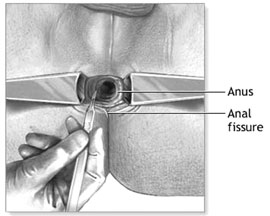 |
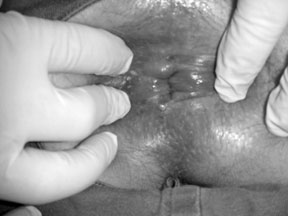 |
| A cut is made in the
sphincter adjacent the fissure |
Anal fissures |
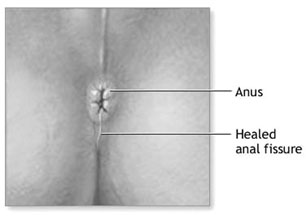 |
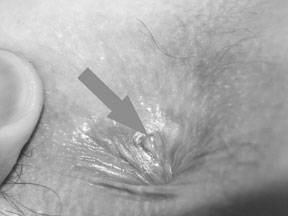 |
If the fissure does not heal with the help of such methods within one
to one and half months doctors may have to resort to surgery. “But the
surgery involved is a non-invasive ‘day procedure’ - the patient can
walk out of the hospital after the surgery - and can be conducted under
local or general anesthesia”, explained Dr. Pathirana.
A cut is made in the sphincter adjacent the fissure. This releases
the sphincter pressure.
“A common fear in patients undergoing this procedure is that they
might lose control of bowel movements, since their main function is
that.”
According to Dr. Pathirana even the percentage of flatus incontinence
(inability to control the passing of gasses from the anus) - which can
be very embarrassing - owing to the procedure, is minimal. “And true
faecal incontinence - total loss of control in bowel movement as a
result of this surgery is extremely rare in medical practice because the
anus consists of several groups of sphincters of which only one is
released.” After some time the sphincter reverts to normal.
Caution
It is apparent that the causes of fissures are most often due to
constipation resulted by unhealthy lifestyles and food habits. In the
hectic lifestyles of people less water intake, constant intake of cola
drinks and caffeine are major contributors of constipation.
“Low fibre diet, instant food consisting of a lot of sugar, oil,
calories, salt, less water and fibre are other major causes of
constipation”, explained Dr. Pathirana. Spending long hours in the
toilet, voluntary delaying of motions and straining during motions
contribute to the development of fissures.
The doctors orders are not to use the toilet as a reading room,
exercise regularly, drink more water take fibre rich food and cut down
on the junk food.
Eating disorders affect vegetarian teens at a higher rate
by Susan Brady
The practice of vegetarianism involves eating a diet that excludes
meat, fish, and poultry, while a variation of the vegetarian diet, known
as the vegan diet, also excludes eggs, dairy products, and honey.
Following a properly planned vegetarian diet can fulfill the nutritional
needs of people of any age and can even significantly lower risks of
cancer and heart disease, as well as other diseases.
However, vegetarianism has become increasingly popular among teens
for various reasons and may put them at greater risk for the development
of serious eating disorders.
 A study published last year in the Journal of the American Dietetic
Association revealed that while young adult vegetarians were less likely
to be overweight than non-vegetarians, about 20 to 25 percent of current
and former vegetarians demonstrated unhealthy behaviours for weight
control. A study published last year in the Journal of the American Dietetic
Association revealed that while young adult vegetarians were less likely
to be overweight than non-vegetarians, about 20 to 25 percent of current
and former vegetarians demonstrated unhealthy behaviours for weight
control.
Among the harmful practices were the use of diet pills, and symptoms
of eating disorders, such as regurgitation, the use of laxatives and
diuretics, as well as binge eating. Lead researcher Ramona
Robinson-O’Brien, assistant professor in the Nutrition Department at the
College of Saint Benedict and Saint John’s University advised,
“Clinicians and nutrition professionals providing guidance to young
vegetarians might consider the potential benefits associated with a
healthful vegetarian diet, [but also] recognize the possibility of
increased risk of disordered eating behaviours.” During the study,
called Project EAT-II: Eating Among Teens, the researchers analyzed data
collected on 2,516 participants including teens and young adults.
Participants were grouped according to whether they were current,
former, or non-vegetarians and each group was split into two sub-groups:
ages 15 to 18 and ages 19 to 23.
The majority of the vegetarians in the study were female.
The participants were questioned about whether or not they had
experienced symptoms of eating disorders: binge-eating, loss of control
of eating habits, or extreme weight-control behaviours.
Approximately 21 percent of former vegetarian teens admitted to
having used unhealthy weight-control behaviours, compared to only 10
percent of non-vegetarian teens. Among the young adults, extreme weight
control measures had been used by 27 percent of former vegetarians, 16
percent of current vegetarians, and 15 percent of those never having
been vegetarians.
The study also showed that binge eating and loss of control over
eating habits were reported by 21 percent of the teen vegetarians as
well as 16 percent of former vegetarians, compared to only 4 percent
non-vegetarians. For the young adults, 18 percent of vegetarians
reported binge eating and loss of control compared to 9 percent of
former vegetarians and only 5 percent of non-vegetarians.Robinson-O’Brien
said that although teens may view vegetarianism as a healthy option,
they could also be motivated by potential weight loss.
She explained, “Adolescents often experience a heightened sensitivity
about their appearance and pressure to conform to a cultural ideal,
resulting in body dissatisfaction and experimentation with various
weight loss methods.”
Healthnews
Rat Fever on the decline but watch out!
by Nadira GUNATILLEKE
The number of Rat Fever (Leptospirosis) cases reported in the last
two months of this year is 306, with four deaths. This is a significant
improvement when compared to last year, Epidemiology Unit Director, Dr.
Paba Palihawadana said.
According to last year over 3,500 cases were reported and the number
of deaths knocked 120 mark. The fever, one of the main health problems,
with farmers, scavengers, miners, people who swim or play in
contaminated water, being the most vulnerable.
The victims should contact the PHI or MOH and obtain Doxycychine
tablets which two tablets should be taken before they start their work.
The tablets gives around 90 percent protection for a period of one
week, followed with two tablets again at the time they finish their
work. Contaminated water such as flood waters should be avoided. Boiled
water should be used for drinking. Paddy fields should be kept clean
without garbage and stagnant water. Persons who have open wounds in
their legs should cover them properly before walking into paddy fields.
Meanwhile the Healthcare and Nutrition Ministry has taken a decision
to use `Biorat’ in Sri Lanka from January next year to curb
leptospirosis. The existing chemicals only kill domestic rats and not
the wild rats who live in paddy fields, drains and other places. The
Ministry is now in the process of obtaining the permanent registration
for `Biorat’ from the Pesticides Registration Department, but the
ministry will use `Biorat’ from January using a temporary registration.
In 2004, `Biorat’ was very successfully used in the Koggala area to
control rats and around 95 percent of rats were destroyed after using
the method. After the tsunami, the area was badly infested with rats and
several cases of leptospirosis reported.
The use of `Biorat’ solved the problem. Therefore `Biorat’ is not
something entirely a new bacteria for Sri Lanka.
The Ministry has already appointed a special committee, as per
request made by the Agricultural Department in order to carry out the
trial and check the impact of `Biorat’ on other species and plants in
the environment. The test is likely to be done in Gampaha which is one
of the badly affected areas by leptospirosis.
The main symptoms of rat fever are sudden onset of high fever, mild
flu, chills, conjunctival suffusion, muscle tenderness (notabl in calf
and lumber areas), severe headache, jaundice and decrease in urine
output.
The symptoms show after 5 to 14 days after infection. It is very
important to seek medical treatment as early as possible from a
Government hospital. The disease can be completely cured if medical
treatment is given on time.
Health News
Still births four times more likely with IVF
A study shows fewer deaths with other fertility plans, but experts
say dangers for pregnancies are still very low
Women who have fertility treatment are four times more likely to have
a stillborn baby than those who conceive naturally, says a study
published today.
It has been known for some time that there was an increased risk that
a baby conceived through IVF (in-vitro fertilisation, in which sperm and
eggs are mixed in a test tube) or ICSI (in which the sperm is injected
into the egg) would be stillborn. But previous studies have not been
able to show the scale of baby deaths.
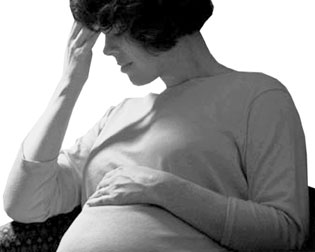 |
|
Women who have fertility treatment
face an increased risk of still birth, compared with those
who conceive naturally. |
Researchers say women contemplating fertility treatment should not be
unduly anxious. Kirsten Wisborg, who led the study, said: “The risk of
stillbirth is still very low after IVF/ICSI. We do not know whether
increased risk is due to the fertility treatment or to factors
pertaining to couples who undergo IVF/ICSI.”
The fourfold difference was between women who had either IVF or ICSI
and women who conceived either naturally or through other methods such
as taking hormones to stimulate their egg production or artificial
insemination.
The study, published in the journal Human Reproduction, involved more
than 20,000 singleton pregnancies in Aarhus, Denmark. Dr Wisborg and
colleagues analysed data that has been kept on pregnant women between
1989 and 2006, who form the Aarhus Birth Cohort.
They had a wealth of data on the pregnancies and outcomes, including
how long it took the women to become pregnant, smoking and drinking
habits, age and education.
Out of 20,166 first-time singleton pregnancies, 82% were conceived
spontaneously within 12 months and 10% after more than a year of trying.
Of the rest, 4% were conceived after IVF or ICSI and 4% after other
forms of fertility treatment. There were 86 stillbirths, giving an
overall risk of 4.3 per thousand pregnancies.
But the risk of stillbirths in women who had undergone IVF or ICSI
was significantly higher, at 16.2 per thousand.
The stillbirth rate among women who had undergone other fertility
treatment, such as hormone stimulation, was lowest, at 2.3 per thousand.
Of those who became pregnant spontaneously within 12 months of trying
it was 3.7 per thousand and among those who took more than a year to get
pregnant it was 5.4 per thousand.
“There has been speculation that the increased risk of adverse
outcomes, in assisted reproduction might be related to infertility.
However, we found the risk was similar between sub-fertile couples,
women who had conceived after non-IVF fertility treatment and fertile
couples.
“This may indicate that the increased risk of stillbirth is not
explained by infertility and may be due to other factors, such as the
technology involved in IVF/ICSI or some physiological difference in
couples that require IVF/ICSI.”
-Guardian,UK
|

